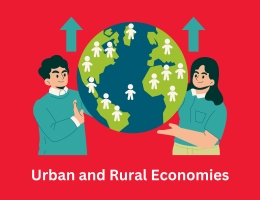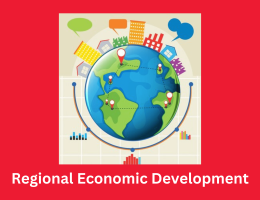
Regional Economic Development: Investigating Disparities and Theories of Growth, Decline, and Convergence
- By admin --
- Thursday, 07 Mar, 2024
Introduction:
"Nearby economic development" refers to the many increase paths and variations in average economic overall performance that can be observed in a couple of places. This presentation explores the subtleties of neighborhood financial improvement by means of searching on the questioning behind community growth, contraction, and convergence as well as the variables growing variations inside and among regions.
Theories of Regional Economic Development:
-
Neoclassical Growth Theory: Neoclassical economists contend that versions in detail endowments, technical improvements, and investment levels are the primary causes of network financial disparities. Areas which might be endowed with a wealth of assets, quite professional employees, and properly-advanced infrastructure normally see higher charges of economic growth than those that do not. The convergence hypothesis, that is based definitely totally on neoclassical idea, postulates that once capital flows and productivity ranges diploma out, poorer areas may ultimately capture as a whole lot as rich ones.
-
New Economic Geography: The recognition of New Economic Geography is on how spatial connections and agglomeration economies shape sorts of close by development. According to the hypothesis, records spillovers, labor marketplace pooling, and economies of scale purpose economic hobby to pay interest in particular areas. Because of this, areas that already have set up agglomerations may additionally additionally furthermore see quicker increase, at the same time as one-of-a-kind regions discover it tough to attract in capital and stay left out.
-
Institutional Theory: Economists that specialize in establishments contend that felony pointers, hints, and cultural norms all have a massive effect on the economic boom of a place. Economic increase is generally driven through areas that have obvious government, green regulatory frameworks, and helping establishments.These projects will also tend to stimulate entrepreneurship, innovation and investment. In terms of opportunities, areas plagued by political turmoil, precarious infrastructure, useful and practical aid from corruption may also find it difficult to grow and may even go through financial crisis.
Disparities in Regional Economic Development:
-
Income Disparities: One of the primary traits of close by monetary development is the disparity in profits amongst areas. Richer regions typically have higher not unusual earnings and further economic possibilities; they may be regularly town centers or places with specialised groups. Poorer groups, however, particularly those which is probably rural or relying on industries which are in decline, might in all likelihood discover it difficult to create jobs and keep a modern-day-day of dwelling, which might exacerbate social and monetary inequality.
-
Infrastructure Disparities: Differences in the utilities, telecommunications, and transportation networks can all be barriers to shut by means of boom. Better connection, a good buy much less transaction prices, and less difficult get right of entry to to markets are benefits of properly-evolved infrastructure, which promote alternate and investment in a vicinity. On the opportunities side, regions with formidable infrastructure find it difficult in terms of economic growth considering formidable communication constraints gain access to market and reduce employment.
-
Human Capital Disparities: Differences in the wonderful workforce, access to training and abilities have a significant impact on local economic growth. High-professional businesses and records-based totally absolutely investments are often interested by regions with quite knowledgeable populations and robust education packages, which spurs innovation and productivity boom. On the other hand, areas with low ranges of education and little get right of access to to training programs need to discover it tough to adjust to transferring marketplace situations, which might likely preserve gaps in employment and profits possibilities alive.
Policy Implications:
In order to mitigate the differences in local monetary improvement, precise insurance interventions that prioritize the improvement of inclusive increase, expanded competitiveness, and convergence amongst regions are crucial. Important coverage responsibilities encompass:
-
Investment in Infrastructure: To growth connectivity, decrease transportation fees, and enhance marginalized regions' get right of get right of entry to to to markets, governments ought to deliver infrastructure development top precedence.
-
Skills Development and Education: Funding for schooling and programs geared in the direction of growing capabilities can empower people and agencies in underprivileged areas, giving them get admission to to new industries and profession possibilities.
-
Regional Development Strategies: In lagging regions, monetary interest and project creation may be boosted through enforcing focused nearby improvement techniques, collectively with agency diversification applications, help for network entrepreneurship, and funding incentives.
Conclusion:
In summary, loads of intricately interacting elements, which consist of institutional frameworks, structural inequities, and economic theories, effect neighborhood financial improvement. In order to sell equitable and sustainable development, policymakers, planners, and stakeholders have to have an extensive expertise of the dynamics of close by increase, decline, and convergence. Societies can try to close the gap among areas and foster shared prosperity with the useful resource of addressing inequities and setting effective insurance answers into place.





